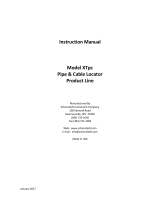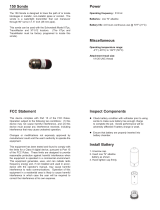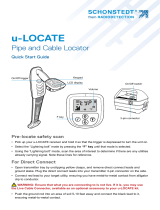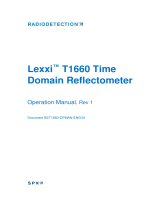
6 RD7000+ Operation Manual
Section 3 – Basic operation
An optional Lithium Ion rechargeable battery pack is
also available for the RD7000+ Tx-1, Tx-5 and Tx-10
transmitters.
The rechargeable battery packs provide an estimated 8-
hour working time, depending on use.
Rechargeable battery packs are available in kits that
include the rechargeable battery pack and an AC adapter
or 12V vehicle adaptor.
The battery packs must be removed from their parent
units before connecting to a power source for recharging.
For more information, refer to the instructions that came
with your charger.
CAUTION! Do not heat the rechargeable battery
pack above 60°C (140°F) as this will damage their
thermal fuses.
NOTE: The batteries are designed to protect against
over discharge, overcharge and short circuit between
charge terminals.
Contact your local Radiodetection representative for
information on purchasing battery packs and chargers.
3.2 System setup
It is important that you set up the system according to
your personal preferences and operating requirements
before you conduct your rst survey. You can set the
system up using the RD7000+ menu as described below.
NOTE: These procedures refer to both the transmitter
and locator unless stated otherwise.
Before changing settings, ensure the locator or transmitter
is switched on by pressing the key for two seconds.
3.2.1 Power frequency (locator only)
Select the correct frequency (50 or 60Hz) for your
country or region’s national power supply.
To change power frequency on the locator:
1. Press the key momentarily to enter the menu.
2. Scroll to the POWER option using the arrow keys.
3. Press the antenna key to enter the POWER submenu.
4. Scroll up or down using the or arrows to select
the correct frequency.
5. Press the key to accept your selection and return
to the main menu.
6. Press the key to return to the main operation screen.
3.1 Starting the system
The locator and transmitter are battery powered. Install
good quality D-cell (LR20) NiMH or Alkaline batteries
into the locator and transmitter battery compartments
or install the appropriate rechargeable battery pack.
Alternatively, you can power the transmitter from a mains
or vehicle power source using a Radiodetection supplied
adapter.
To switch the locator or the transmitter on, press and hold
the keypad Power Key for two seconds. When you switch
the system on it will perform an LCD segment check.
It will then display the model number followed by the
software version. This information is important if you need
to contact Radiodetection technical support or update
your locator to the latest software.
NOTE: Once the system is switched on, pressing the
Power Key momentarily will activate the locator or
transmitter menu.
3.1.1 D-cell (LR20) Batteries
The LCD provides a battery level indicator (refer to
the diagrams in Sections 2.1 and 2.2). When battery
replacement is necessary, the LCD shows a ashing
battery icon. The expected alkaline battery life under
normal working conditions is approximately 30 hours on
the locator and 15 hours on the transmitter.
NOTE: Prolonged use of high power output on the
transmitter will reduce battery life.
To replace the batteries on the locator, unlatch the
battery compartment cover, which is located above
the accessory panel, and lower the tray. Remove the
spent batteries and insert two D-Cell Alkaline or Ni-Cad
batteries.
To replace the batteries on the transmitter, unlatch the
accessory tray. The battery compartment is located
underneath the transmitter body. Use the turnkey to
unlatch the battery compartment. Remove the spent
batteries and insert eight D-cell (LR20) Alkaline or Ni-Cad
batteries.
NOTE: When installing batteries always observe the
correct battery polarity as indicated on the battery tray.
3.1.2 Rechargeable battery packs
An optional NiMH Rechargeable battery pack is available
for the RD7000+ locator. This pack is interchangeable
with other Radiodetection Precision Locators that use 2
D-cell ( LR20) batteries.

























